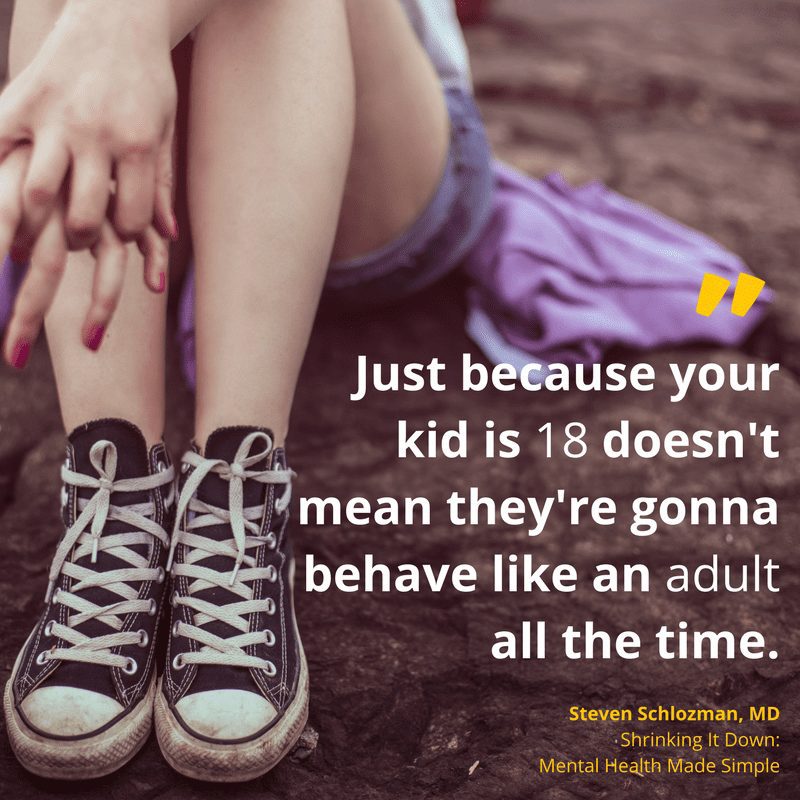What Is The Developing Brain?

Posted in: Pre-School, Teenagers
Topics: Child + Adolescent Development
There’s been a lot in the news about the “developing brain.”
It might seem silly that we get all excited about the fact that the brain develops. Of course it develops, you might argue. Kids grow up. They learn things. They get more coordinated, more sly, more…well…grown. It’s not like they’re becoming increasingly savvy because of their kidneys. It can only come from all the goop that sits packed almost uncomfortably tightly inside their skulls. That organ, the BRAIN, is the source of poetry, and love, and hate, and bad 80s music. And, that organ is what changes more than anything else as kids get older.
So, why do clinicians get all excited over these seemingly obvious facts?
Because it’s only in the last 20 years or so that we’ve even had the tools to understand these changes at the level of the neuron. In others words, we now have real scientific data to jive with our empirical observations about how kids behave. From that data we can glean treatments, both via talking, and through medications and devices.
But, more on that later. Let’s start by reviewing what we mean when we say that the brain “grows up.”
Here’s what we DON’T mean: we DON’T mean that brain gets bigger. Our brains are about as big are they’re going to get by the time most of us are around 5 years old. So, to misuse the cliché, when it comes to brains, size really doesn’t matter.
This can also help explain that vexing set of questions that lots of kids ask when they’re first introduced to neuroscience. A horse seems to have a larger brain than a Yorkshire terrier, for example; but, that yorkie is a heck of a lot smarter than that horse.
The difference, it turns out, is not in the size of the brain, but more so in the stuff that goes into the brain’s composition. A simple way to look at it is this: the brain has gray matter (neurons), and white matter (the connections between the neurons). These two aspects of the brain change dramatically as we go from babies, to toddlers, to school-aged kids, to adolescents. But, in order to make sense of this, we need to talk for a moment about what the neurons and the connectors actually do.
The neurons hold little bits of information and instructional material—that’s the easiest way to put it. Those little bits of information are worthless, though, if they can’t be experienced throughout the body. If a set of neurons says “make a fist,” for example, but lacks adequate connections to the fist-making apparatus, then you can think “make a fist” all you want; there just isn’t going to be a fist. It would be like having a very cool car, but no roads on which to drive. Each car would sit there on its own special island; without those roads, the cars wouldn’t be able to visit one another.
Here’s where the white matter, the stuff that makes up those CONNECTIONS, come in to play. These connections allow neurons, through structures called axons and dendrites, to talk to each other. If little packets of information are the cars in the neuron’s garage, then these information-carrying cars travel along the white matter connections to transmit their information across the brain. And, it is in the connections among neurons where the biggest changes take place during brain development.
Perhaps the most surprising discovery about brain development is the strange fact that neurons themselves start to disappear around adolescence. This is called pruning ; the neurons are trimmed back steadily and exponentially with the onset of puberty, and this process continues until the fourth or fifth decade of life. Conversely, however, the connections between neurons exponentially grow during adolescence. This means that teens are seemingly smarter than littler kids not because they have more neurons, but because they have more connections between their neurons. In fact, it is theorized that the neurons themselves disappear in adolescence in order to allow the myriad connections to form. You simply need to clear out some neurons to make room for all those roads.
So, teens are smarter because they have FEWER neurons than littler kids, but more connections among the neurons that they continue to use. If you think about it, this makes sense. Individual packets of information are not that useful. But, if you can combine information with other multiple sources of information, you develop the biological capacity to think abstractly. It’s why we teach Shakespeare during adolescence, but How To Eat Fried Worms to younger kids. Shakespeare is morally ambiguous. Eating fried worms is just gross. To tolerate the uncertainty of Shakespeare, a lot more neurons need to talk to each other.
But, this of course brings up an interesting question: if adolescents have more neurons and connections than adults, then why, biologically speaking, do teens do silly things? Why would a teenager accept a dare to drive a zillion miles an hour on the freeway, but most adults would not? Shouldn’t a teenager have enough brain power, literally, to know better?
It turns out that for teens, socially-loaded moments like peer-pressured dares are often dealt with without engaging those multiple and highly-connected higher brain neurons. The dare to drive recklessly stirs up the teen; the teen feels the power of the dare most acutely in the primitive regions of the brain, but the signal can’t get to the higher brain where better judgment processing can occur.
This is because the white matter that connects the lower and higher brain is itself incomplete. If we use our car analogy, the cars parked in the primitive brain can’t really get onto the road to the higher brain because the white matter is too slippery. White matter is literally white because it is made of myelin, which is an insulating protein that allows signals to travel efficiently along neural pathways. Because the myelin is not fully formed, the signal skids off the road, and the teen feels instead the signals received and processed by the best insulated connections. It turns out that those connections are in the very regions of the brain that predispose to poor judgment. Voila! Teens act like teens.
What does this mean from a therapeutic standpoint? A good deal, it turns out, for both parents and clinicians.
For parents, it’s important to remember that adolescents are not seeing the same world that you see. Where you see a confused face, teens more likely see an angry face. Where you see a sad face, teens more likely see an angry face. And so on. Teens are much more likely to perceive angry disapproval from both adults and peers.
This isn’t just conjecture; multiple studies have confirmed that teens are more likely to view confusing expressions as aggressive expressions. When teens experience these perceived threats, their brains, as measured on functional MRI, show greater activation in the lower regions of the brain, and less activity in the very parts of the brain that would allow them to more accurately interpret a situation. If adults can keep this in mind, they can remember to actively look less threatening. They can lower their voices. They can remain calm. The teen brain will more likely respond in kind.
The same, of course, goes for therapists. Many adolescents will understandably approach therapy as a threatening situation. Good therapists are keenly aware of this misperception; in other words, the therapists know that they seem threatening to the teen even if they themselves have no intention of seeming off-putting at all. That’s why building an alliance is so important.
We know that littler kids are more clear-cut. Their brains are not, in fact, wired for suspicion. But, little kids need an alliance with their therapists too. For the younger child, this comes from understanding the currency of the child, such as playing and playfulness, written about here. Also, check out this post to read about the dominant theories of child development.


 Share
Share Tweet
Tweet




